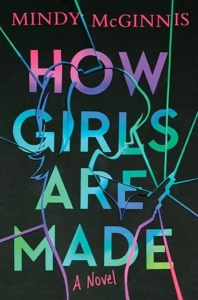How Girls Are Made
Mindy McGinnis
HarperCollins
Published November 18, 2025
Amazon | Bookshop | Goodreads
About How Girls Are Made
Sex Education meets Euphoria in this dark contemporary novel that tackles perfectionism, emotional abuse, and the dark side of social media.
Fallon is a fixer. From planning prom to organizing her college applications, she’s got it all figured out… except for when her younger sister comes to her with very basic questions about sex. Shocked that she knows so little—and her fellow classmates even less—Fallon decides some practical education is in order. And Fallon isn’t above practicing a little civil disobedience by creating a secret, underground, off-campus group.
Shelby is a fighter. Having her nose broken is nothing new in her semi professional career… but this time it’s her boyfriend that threw the punch. Now her phone is blowing up with texts from a new guy, who tells her she’s perfect, she’s special, she’s everything he’s ever wanted… except for a few small details. Shelby’s happy to adjust for him, because isn’t that what a healthy relationship is about?
Jobie is a failure. She doesn’t have enough followers and her posts never go viral, no matter how hard she crushes challenges and applies exactly the right filter. But a friendly DM from a good girl just like her points her in the direction of a whole new audience of admirers. Guys who just want to talk. Guys who give her the attention she’s always wanted.
The lives of all three girls intersect in Fallon’s secret class, rumors of which have parents up in arms. Fallon needs to keep herself anonymous, Shelby needs to keep her new boyfriend happy, and Jobie needs to keep her followers… who keep asking for more. Each girl finds herself trapped in an inescapable situation—that will leave one of them dead.
My Review
Not gonna lie, this book is a hard read. It’s such a compelling story. I couldn’t stop thinking about it, even after I finished reading. These are hard topics to write about for teens, and I think the author does a good job scaling the topics to the audience.
I also really appreciate that each of the main characters seem, on the surface, like they’d be insulated from the kinds of trouble they face. Fallon’s conundrum felt the least unexpected, but Jobie and Shelby both read as the kinds of girls who pretty well stay clear of trouble. Shelby, as a wrestling athlete, is not easily pushed around. Her personality is big, frank, and unapologetic.
And yet, we watch her face intense, painful situations that her physical strength can’t spare her from. As much as she wants to shake off the hurt, sometimes she can’t. Her experiences remind us that having a reaction to trauma doesn’t make us weak. It makes us real.
The ending of the book unfolds at a wild pace, with all three girls in increasingly dire circumstances. Periodic italicized scenes from an omniscient point of view remind the reader that one of these girls doesn’t make it through these events alive.
This certainly won’t be a book everyone wants to read, but I’m so glad that there are books for a young adult audience tackling these topics. Education about abuse, intimacy, and online safety can quite literally save lives. I wish that the book included a note in the back offering resources for readers who need help navigating any of the situations that the main characters face. For example, RAINN, a nonprofit organization, offers help for abuse survivors.
Fans of Courtney Summers, especially Sadie or All the Rage will want to read this one.
Content Notes
Recommended for Ages 16 up.
Profanity/Crude Language Content
Strong profanity used somewhat frequently. Some scenes show cruel or disturbing social media comments or messages.
Romance/Sexual Content
Fallon and the girls in her club answer questions from other students about sex and sexual situations (pregnancy prevention, STI transmission, consent, etc.) The information stays pretty generalized. The group discusses the exchange of nude photos and how it’s illegal to send or receive them if the person photographed is under 18 (even if it’s a selfie).
Other references to sex. One scene leads up to a sexual encounter. Another scene leads up to a coerced sexual encounter. Later, someone discovers a video of this experience, obviously recorded without consent.
Spiritual Content
None.
Violent Content
One scene shows domestic abuse. The story catalogs an emotionally abusive relationship. Shelby practices wresling with a partner. At one point, someone body slams another person without their consent.
One scene shows an overdose. Another shows a serious car accident. Another shows a fatal accident.
Drug Content
Shelby drinks alcohol at a teen party. One character swipes someone’s pain medication and takes multiple pills.
Note: This post contains affiliate links, which do not cost you anything to use but help support this blog. I received a free copy of this book in exchange for my honest review. All opinions are my own.
